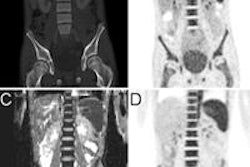In addition, PET/MRI provides better soft-tissue contrast, which suggests that DOPA-PET/MRI should be considered in all infants with CHI, according to lead author Dr. Maria Boviatsi-Gavra.
"DOPA-PET/MRI is a novel technique that can positively differentiate between focal and diffuse congenital hyperinsulinism in pediatric patients," Boviatsi-Gavra told AuntMinnie.com. "PET/MRI has a significantly lower radiation burden compared to PET/CT, as MRI does not have any radiation exposure. The reduction of the radiation dose from PET/MRI is particularly beneficial to the pediatric population."
In this study, 12 patients with CHI (median age, 6.7 months) underwent imaging on a 64-slice PET/CT scanner (VCT, GE Healthcare), along with 3-tesla PET/MRI (Biograph mMR, Siemens Healthcare).
Dynamic PET scans were acquired 20 and 40 minutes after injection of 4 MBq/kg of F-18 DOPA, with contrast-enhanced CT. PET/MR included T2-weighted, diffusion-weighted, and T1-weighted volumetric interpolated breath-hold examination (VIBE) postgadolinium imaging 90 minutes after DOPA injection.
Maximum standardized uptake values (SUVmax) were measured in the head, body, and tail of the pancreas at 40 minutes with PET/CT and at 90 minutes with PET/MRI.
All images were of diagnostic quality. Two patients were diagnosed with focal CHI and the other 10 infants had diffuse CHI. In four cases, there was greater confidence in identifying the different types of CHI with PET/MR than PET/CT.
The results were concordant in all 12 patients with both imaging methods. The two patients with focal uptake underwent surgery with histopathological confirmation.
"These MR sequences can help us clarify the location of blood vessels, the common bile duct, and adjacent soft tissue and define their relationship to the hot spots in the pancreas before surgery," Boviatsi-Gavra said. "This superior contrast imaging with PET/MR can contribute significantly to the preoperative situation."
The researchers plan to study more pediatric patients with congenital hyperinsulinism, particularly those with the focal form of the disease.



















